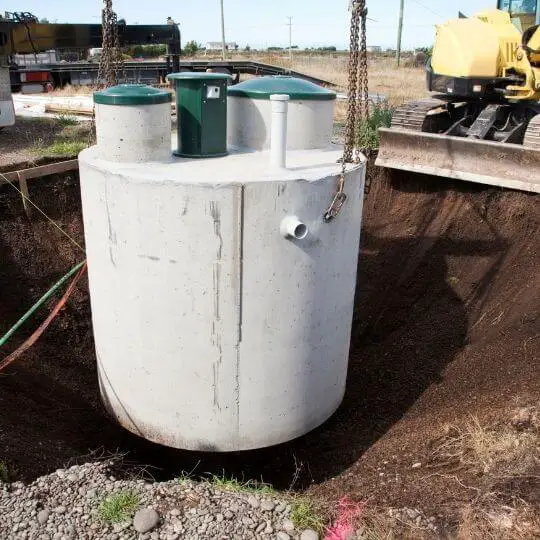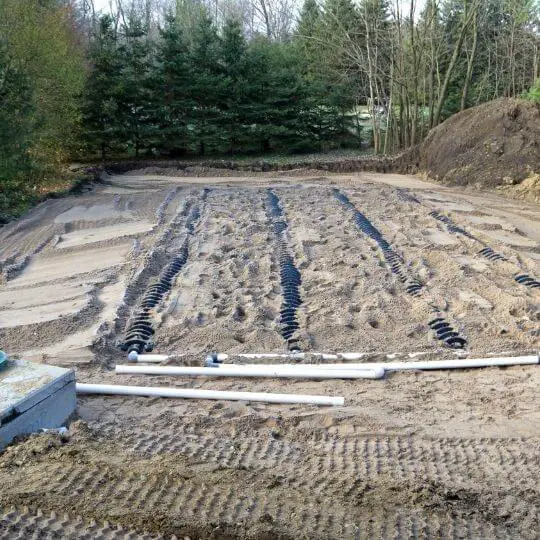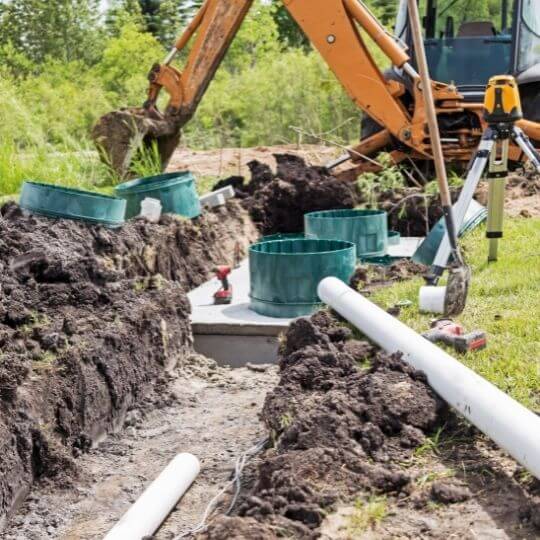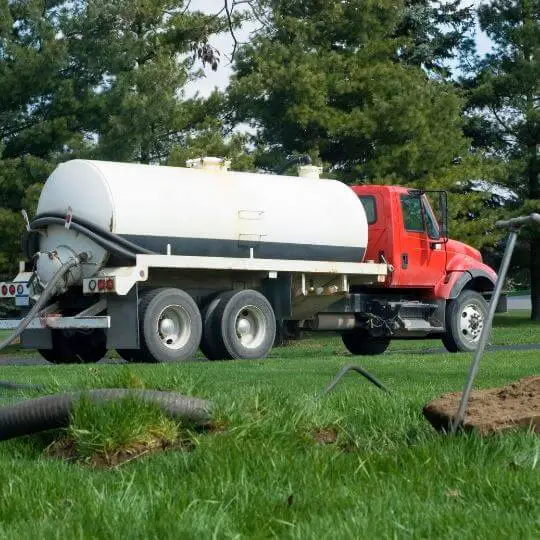Are you researching septic systems for use at your home or business? Wondering “what is an anaerobic septic system”?
There is a lot of information on the subject. Before making a choice, you will need to determine which size and type suit you best. [1]
The type of processes that break down waste represents another important factor to consider. That is, whether you will opt for an aerobic or an anaerobic septic system.
In this post you will find the answer to “What is an anaerobic septic system?”
We will be also making a comparison between aerobic vs. anaerobic septic system. After reading this article you will find it easier to choose the right system for your needs.
The important thing is to choose what works best for you.
What does anaerobic mean?

The term ‘anaerobic’ simply refers to the absence of free oxygen.
The concept is used in multiple areas, including biology and sports.
In biology, anaerobic refers to microorganisms that do not need free oxygen to exist and thrive. Anaerobic respiration is a process enabling organisms to get energy in the absence of oxygen. For instance, yeast used to make alcoholic drinks reproduce rapidly and consume all the available oxygen. So, they have to switch up to anaerobic respiration to be able to survive.
In sports, anaerobic refers to a type of exercise. The anaerobic exercise does not increase the efficiency of the body’s cardiovascular system in absorbing and transporting oxygen. While doing anaerobic exercises, your body uses stored energy sources as a fuel. Examples of anaerobic workouts are sprints and high intensity interval training, which force our bodies to break down glucose.
The two concepts are closely related. Human cells, like bacteria, can switch to anaerobic respiration. This happens when the body does not manage to supply enough oxygen to ensure aerobic respiration –e.g., during vigorous exercise.
But let’s go back to the topic that concern us on in this post, and that is anaerobic septic systems.
So, what is an anaerobic septic system and how it works?

Anaerobic septic systems use bacteria that can live without oxygen. Solid waste settles to the bottom of the tank and is eaten by anaerobic bacteria.
Liquid waste rises to the top and moves out to the smaller pipes under the surface. These pipes have holes at their ends to allow wastewater to percolate out into the ground. This treated effluent is relatively clean and safe to release into the surrounding soil.
Anaerobic septic systems are often used for industrial wastewater rich in biodegradable organic matter. This method is preferred due to being energy efficient and more cost-effective. [2]
What are the pros and cons of an anaerobic septic system?
Anaerobic septic systems are often preferred to their aerobic counterparts for reasons we will explain later in the article. Regardless of aerobic vs. anaerobic septic system comparison, the anaerobic solution provides some advantages:
· Anaerobic systems generate less sludge;
· Sludge resulting from anaerobic systems can be used to enrich soil;
· Anaerobic septic systems work without the use of chemicals;
· Anaerobic septic tank design is simpler, which makes this option more affordable;
· Costs associated with handling sludge are lower for anaerobic systems;
· Anaerobic systems produce biogas, which can be used to produce electricity.
However, there are a few disadvantages when it comes to the use of anaerobic septic systems:
- Wastewater takes longer to break down in an anaerobic septic system;
- Anaerobic septic systems can have issues with handling excess fats and oils;
- Using harsh chemicals such as ammonia can have a negative impact on anaerobic bacteria in your septic system.
In order to minimize some inconveniences, the anaerobic drip septic system has been developed. These systems distribute wastewater to the lawn through a system of pipes buried below the surface of your yard.
Advantages of anaerobic septic systems with drip irrigation include:
- Being able to use it at most sites;
- Can be used in sites with moderately saturated conditions;
- It requires less surface than a spray distribution system;
- Effluent is uniformly distributed in the lawn where it is reused by plants.
A few drawbacks persist, however. If the system is installed on steep slopes, pressure compensating emitters need to be used. Those emitters can get clogged with organic matter and solids if the system is not properly maintained.
This is why you will need to pump the treatment systems every 2 or 3 years. This prevents solids from entering drip tubing.
What is the difference between an aerobic and an anaerobic septic system?

Unlike anaerobic septic systems, aerobic ones rely on the use of oxygen to speed up the decomposition process.
Here are some things that are different in aerobic septic systems:
- Design
Aerobic septic systems have a different design and often include three tanks.
The first tank works like an anaerobic system, where wastewater settles into layers.
In the second tank an aerator introduces oxygen bubbles inside the waste. This helps aerobic bacteria to consume the waste.
Afterwards, wastewater reaches a third tank where it is treated once more. Eventually wastewater is distributed into the soil under your lawn.
So, a major design difference is that aerobic septic systems have an aerator. This unit powered by electricity forces oxygen into the main treatment tank.
- Efficiency
Aerobic bacteria are more active than anaerobic ones. As a result, they are able to treat wastewater faster and more efficiently.
- Adaptability
In some properties, soil condition can be inadequate for wastewater treatment. Under these circumstances, aerobic systems tend to perform better.
- Safer for the environment
Is your property located close to surface water bodies? Effluent that is not treated properly can contaminate natural water courses and groundwater. This is less likely to happen with aerobic septic systems.
Which option is better – aerobic or anaerobic septic system?
With aerobic systems being more efficient, you may be tempted to prefer them to the more common, anaerobic ones. But advantages often come with inconveniences, and aerobic systems can pose the following problems:
- More chances to deal with malfunctions
Aerobic septic systems are more complex and there is a higher chance of something going wrong. You have an aerator that is powered by electricity, as well as a paddle that agitates wastewater. Its role is to prevent wastewater from separating into three different layers.
Such a system requires more maintenance and costs more to own, install, and operate. [3]
- Higher installation costs
Installing aerobic systems is more expensive due to added machinery (aerator, multiple chambers). This can represent a drawback for homeowners who are on a tight budget.
- Higher maintenance costs
The additional mechanical parts of an aerobic septic system require more routine maintenance lawn. The reason is because they are simply susceptible to mechanical malfunction.
Aerobic septic systems sometimes come with an alarm that alerts homeowners when there are problems within the system. Using an alarm system is important because undetected septic system problems can worsen and lead to expensive repairs.
- Blower noise
The presence of working mechanical parts obviously represents a source of noise. Whether it bothers you or not depends on your personal noise tolerance levels.
- The need for insulation
Cold weather can have negative effects on aerobic septic systems. This means you will need to insulate your septic system if you live in a cold area.
- Increases in the electricity bill
Because aerobic septic systems require electricity to operate, they will increase your monthly electricity expenses.
How do you ensure the functionality of your anaerobic septic system?

Considering the additional costs and maintenance associated with aerobic septic systems, anaerobic ones may seem like a better choice.
But even if you resort to this simpler solution, there are some good practices to keep in mind:
- Being careful about the items you flush
When using a septic system of any kind make sure you never flush anything but human waste and toilet paper. Items such as wipes, even flushable ones, do not break down and can cause clogs in your septic system pipes. If you know what is an anaerobic septic system about, you will not flush anything that doesn’t belong there.
- Taking care of bacteria
Avoid flushing harsh chemicals especially ammonia as they can destroy the bacteria in your septic system. Even taking antibiotics, which are excreted through urine, can damage the useful bacteria in your septic tank.
- Regular desludging
All septic systems should have the sludge pumped out every couple of years. The drain can become clogged with solids if you don’t remove them regularly.
To Sum Up
Now that you know what is an anaerobic septic system, is this the right choice for you?
It can be, if you don’t risk contaminating nearby water sources. Anaerobic systems are often preferred by those looking to save money and avoid maintenance work.
Such septic systems are usually the norm wherever a municipal sewerage system is not available.

Michael Davis is a heating & plumbing expert who currently works as independent contractor in SC. He also writes for Plumbertip.
For almost 10 years he worked on various plumbing tasks across South Carolina.



